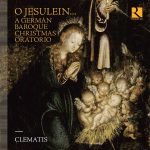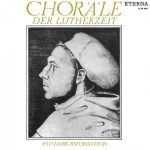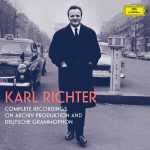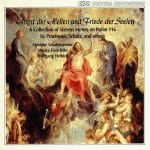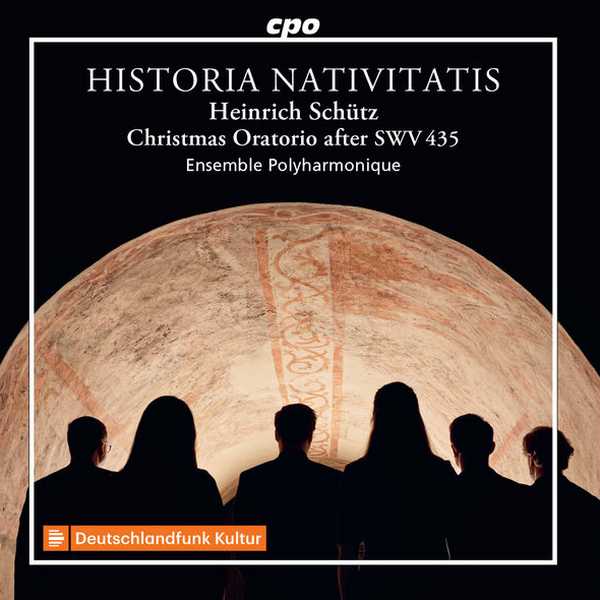

Performer: Ensemble Polyharmonique, Magdalene Harer, Johannes Gaubitz, Joowon Chung, Alexander Schneider, Joowon Chung, Sören Richter, Matthias Lutze
Format: FLAC (tracks)
Label: CPO
Catalogue: 555432-2
Release: 2022
Size: 493 MB
Recovery: +3%
Scan: yes
CD 01
01. Hammerschmidt: Freue dich sehr, du Tochter Zion
02. Michael: Das Volk, das im Finstern wandelt
03. Schütz: Sei gegrüßet, Maria, du Holdselige, SWV 333
04. Eccard: Ubers Gebirg Maria geht
05. Franck: Hosianna dem Sohne Davids!
Rosenmüller: Sonatae à 2, 3, 4 e 5 stromenti
06. Sonata No. 6 à 3
07. Schütz: Ein Kind ist uns geboren, SWV 384, Op. 11 No. 16
Schütz: Historia der Geburt Jesu Christi, SWV 435
08. Es begab sich aber zu derselbigen Zeit
09. Calvisius: Joseph, lieber Joseph mein
Schütz: Historia der Geburt Jesu Christi, SWV 435
10. Und es waren Hirten in derselbigen Gegend
11. Hammerschmidt: O ihr lieben Hirten fürchet euch nicht
Schütz: Historia der Geburt Jesu Christi, SWV 435
12. Und alsbld waren Engel
13. Ehre sei Gott in der Höhe
14. Und da die Engel von Ihnen gen Himmel fuhren
15. Otto: Lasset unsnun gehen
Schütz: Historia der Geburt Jesu Christi, SWV 435
16. Und sie kamen eilend
17. Praetorius: Es ist ein Ros’ entsprungen
Schütz: Historia der Geburt Jesu Christi, SWV 435
18. Maria aber behielt alle diese Worte
Scheidt: Magnificat, SSWV 299
19. Va. Psallite, unigenito
CD 02
01. Dulichius: Also hat Gott die Welt geliebet
Schütz: Historia der Geburt Jesu Christi, SWV 435
02. Und da acht Tage um waren
03. Schein: Lobt Gott, ihr Christen, allzugleich
Schütz: Historia der Geburt Jesu Christi, SWV 435
04. Da nun Jesus geboren war
05. Hammerschmidt: Wo ist der neugeborne König der Juden?
Schütz: Historia der Geburt Jesu Christi, SWV 435
06. Da das der König Herodes hörete
07. Carl: Zu Bethlehem im jüdischen Lande
Schütz: Historia der Geburt Jesu Christi, SWV 435
08. Da berief Herodes die Weisen heimlich
09. Carl: Ziehet hin und forschet fleißig nach dem Kindlein
Schütz: Historia der Geburt Jesu Christi, SWV 435
10. Als sie nun den König gehöret hatten
11. Gesius: Deo dicamus parvulo nato
Schütz: Historia der Geburt Jesu Christi, SWV 435
12. Da sie aber nun hinweggezogen waren
13. Briegel: Stehe auf Joseph (1)
Schütz: Historia der Geburt Jesu Christi, SWV 435
14. Und er stund auf
15. Briegel: Stehe auf Joseph (2)
Schütz: Historia der Geburt Jesu Christi, SWV 435
16. Und er stund auf und nahme das Kindlein
17. Schütz: Das Wort ward Fleisch, SWV 385, Op. 11 No. 17
18. Scheidt: In dulci jubilo
A Christmas oratorio Inspired by Schütz. During the seventeenth century the “historia” developed in Protestant church music as a genre telling the Easter, Passion, and Christmas stories in the words of Luther’s Bible. The Dresden chapel master Heinrich Schütz, who was renowned far and wide already during his lifetime, drew on this form as early as 1623. And when he had published his Weihnachtsthistorie in 1664, it replaced the older historia in the setting by Rogier Michael, Schütz’s predecessor as chapel master, though Schütz retained most of Michael’s text.
As manifold tractates and introductions in printed music of the seventeenth century often indicate, the works to be performed are to be presented in keeping with the circumstances and resources available in the performance location. Accordingly, Schütz also let it be known in his introduction to the Weihnachtshistorie that he “left it open [to composers] to set these ten concertos (whose texts are also to be found in these printed pages) in a manner pleasing to them and for the corpus musicum available to them, either entirely anew by themselves in a different way or to have them composed by others”.
This idea inspired the members of the Polyharmonique Ensemble to produce an alternative version of the Weihnachtshistorie that would be practicable for their particular ensemble. The resultant “Historia Nativitatis” strictly follows the formal intention of Sagittarius Schütz and was set for a “corpus musicum” of six voice parts, two violins, curtal, and a colorful basso continuo (organ, regal, theorbo, Baroque harp, violone).
Contemporary sources, primarily from Central Germany, some of them otherwise unknown compositions by Andreas Hammerschmidt, Samuel Scheidt, Wolfgang Carl Briegel, Johann Georg Carl, Stephan Otto, and others, that exactly follow the source texts are extant. What we have before us is a historia such as might have been heard at a Christmas vespers service in Central Germany during the seventeenth century. It combines magnificent art music with traditional Christmas melodies of Central German provenance and during its course is transformed into a spirited oratorio, interpreted here by the famous Polyharmonique ensemble with attention to historical performance practice.
